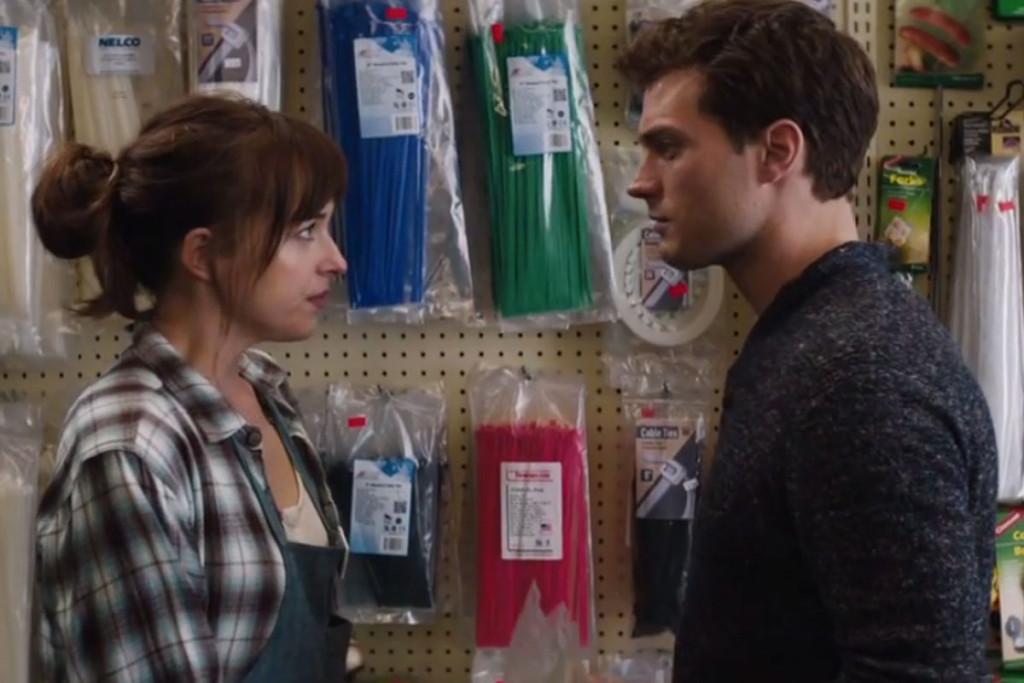There’s something to say about a film so enthusiastic as “Fifty Shades of Grey.” From its first, opening shot of churning, grayscale clouds, it presents itself with a certain dignity that assures viewers the following film could be nothing but a markedly mature and composed look into a tumultuous, passion-filled tryst. This impression, however, quickly evaporates, and what is left is a cinematic tumbleweed of sex, stares and shallow characterization. Paired with some wholly irresponsible commentary on relationship dynamics, the film ultimately vaults past the zone of mediocrity into the realm of impressively, astonishingly horrendous.
Based on the 2011 novel of the same name written by E.L. James, “Fifty Shades of Grey” follows Anastasia Steele (Dakota Johnson), a 21-year-old college student who finds herself in the office of wealthy businessman Christian Grey (Jamie Dornan). Anastasia, who is interviewing Grey for her journalist roommate, Kate (Eloise Mumford), is immediately struck by Christian. Shortly after their first meeting, Christian begins a campaign of gift-giving and smooth-talking, ultimately bringing her into his extravagant world of kinky sex, fast cars and emotional confusion.
This setup, at first glance, sounds like the archetypal platform for any “unlikely couple” romance film — “Titanic,” for instance, often toyed with the notion of rich-meets-poor love. In this respect, “Fifty Shades of Grey” is much like “Titanic,” except the titular, sinking ship has been replaced with light bondage and nonstop emotional torture.
“Fifty Shades of Grey” has, arguably, earned its notoriety thanks to the controversy surrounding its sex scenes, which feature bondage, flogging and other assorted, so-called “deviant” acts. These concepts have had a perplexing effect, distracting audiences from a far more frightening notion than a bit of bed-side roughness: the romanticized emotional abuse of a main character who is consistently portrayed as young, naive and sexually inexperienced. Most denizens of the Internet have likely encountered posts decrying this premise, and it’s safe to say they have full merit in their statements — be it the sexual contract Christian demands Anastasia sign to surrender herself to him, or the fact that he entirely does away with said contract after a few moments and has sex with her, make for a wholly disturbing dynamic that betrays the romantic image the film so desperately grasps for. Instead, what is offered up is a tirade of emotional abuse, ultimately crafting a profoundly warped image of how any relationship, anywhere, should function.
From here, the film fails to redeem itself. Disregarding the questionable moral ground “Fifty Shades of Grey” walks on, and instead considering it as a movie, there remains to be very little to enjoy in the film’s 2-hour runtime. Johnson’s performance is heavy on lip-biting, pouting and sleepy eyelids, and her line delivery often leans more toward lobotomized than her intended, wistfully-in-love disposition. Pair this with Dornan’s brooding, robotic portrayal of Christian, and the ultimate result is a heinously boring film, following two lovers who spend the majority of their time either staring quietly at one another or exploring the many intricacies of their own bodies.
The sex scenes are, interestingly enough, the least-excruciating moments in the film, though this doesn’t exclude them from being exceedingly campy. The purpose these scenes end up serving is as respite from the excessive, pervasive strangeness of Anastasia and Christian’s relationship outside of the bedroom. The kinkiness is there in spades, for certain, but compared to the shallow, abusive and confused characterization of both characters, it seems entirely more orthodox.
Perhaps the only compliment one can give to “Fifty Shades of Grey” is its style, which is admittedly well-executed. Christian’s office is classic, modern swank, and viewers may find themselves gawking at the endless, marble tables and city skylines, both of which provide a welcome distraction from everything else happening in the movie.
What is undoubtedly the most shameful thing of all, however, is that “Fifty Shades of Grey” has found a space in theaters in the first place and will ultimately distract viewers from other, far more deserving films that simply do not boast the notoriety that this film does. This sad notion, paired with the irresponsible and unabashedly dull romance the film presents, make it hard to have any sympathy for the film whatsoever. With this in mind, backed by the moral questionability and sheer inaneness of the plot, it seems appropriate to award this film absolutely no stars. Instead, it is encouraged that audiences look elsewhere in the hopes of finding some other tantalizing form of entertainment.





















